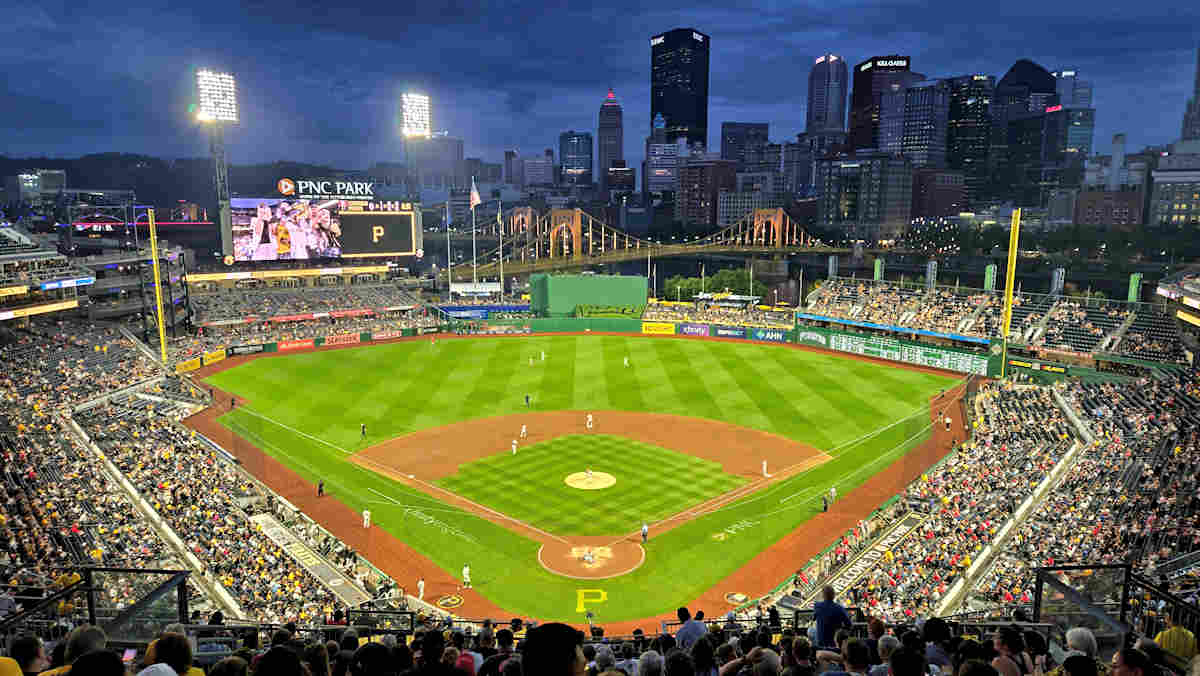
Joe Mock
An edited version of this article appeared in USA TODAY Sports Weekly
Used by permission. All rights reserved on text and photos
PITTSBURGH Over a century ago, this city had an identity crisis. While the Federal Government formally spelled the city’s name as “Pittsburg,” local residents wanted an “h” on the end.
In 1911, the locals carried the day, as Washington, DC relented and added the “h” in all citations about the city. Perhaps out of habit, the city’s largest newspaper continued to call itself the Pittsburg Press until 1921.
Recently, the Pittsburgh Pirates decided to have fun with the silent “h.” On the main concourse of PNC Park, there is now a concession stand called Ballpark Burghers. There for $15.75, fans can purchase the oversized All Star Burger with fries.
This is just one example of the way PNC Park, approaching its 25th season, keeps things fresh for its fans. And they do it in an endearing, fun way.
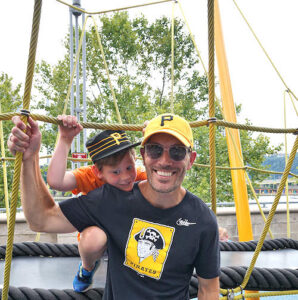 John Weiland of the Pittsburgh suburb of Monroeville has a “mini plan” for tickets for 20 games each season, often bringing his five-year-old son Hugh with him to see the Pirates. “We love baseball, but the team here has been up and down. The ballpark though is always good, it’s always consistent,” the elder Weiland says while watching Hugh play on pirate-ship-themed playground equipment (see photo), a recent addition to the park.
John Weiland of the Pittsburgh suburb of Monroeville has a “mini plan” for tickets for 20 games each season, often bringing his five-year-old son Hugh with him to see the Pirates. “We love baseball, but the team here has been up and down. The ballpark though is always good, it’s always consistent,” the elder Weiland says while watching Hugh play on pirate-ship-themed playground equipment (see photo), a recent addition to the park.
“I’ve been to other parks, and they can feel stale after a few years,” he adds. “Here it never seems stagnant. The park always feels new because it’s always reinventing itself.”
And with a nod to the mascot race that is one of the Pirates’ most beloved traditions, he adds, “We always make sure we’re in our seats for the Pierogi Race after the 5th inning, because Hugh loves them.”
All of the fun promotions and ballpark reinventing has worked. A ranking of the 30 MLB parks by USA TODAY’s baseball writers and editors earlier this season placed PNC Park at number 1.
Continuing to evolve
Teams know the importance of maintaining their ballpark and adding new features. This is especially true for a team that considers itself a small-market franchise without the resources to stockpile expensive free agents.
When Pirates’ principal owner Bob Nutting hired Travis Williams from the NHL’s New York Islanders to become president of the team in 2019, both knew the franchise’s park represented an incredibly valuable asset. It was an asset, though, that needed nurturing.
Williams says that PNC Park “is the best ballpark in America, in our minds. It’s a great place to start, but we know it’s 20-plus years old and that you need to continue to evolve.”
And that’s exactly what the Pirates did. Nutting made a commitment of money and resources to revitalize the ballpark, and they brought in a major name in sports architecture to bring it to life.
Janet Marie Smith is revered for a number of ballpark projects over the past three decades. She championed the retro look of Oriole Park at Camden Yards while integrating it seamlessly into downtown Baltimore. As Fenway Park was approaching its 100th birthday, she oversaw its numerous renovations. When new ownership took over the Dodgers, she was put in charge of dozens of improvements, and eventually the spectacular $100 million reimagining of Dodger Stadium’s outfield pavilion. And she was behind one of the most creative and innovative Minor League parks ever built, as Worcester’s Polar Park opened in 2021.
And now she can add PNC Park’s improvements to her long list of ballpark accomplishments.
Smith, the founder of ballpark advisors Canopy, was asked by Nutting and Williams to visit them at PNC Park in 2021 and make suggestions. “My response initially was, golly, you are consistently a fan favorite throughout the nation. It’s an identifying feature of Pittsburgh, so I don’t know how I could make it any better.”
But Nutting and Williams insisted that they didn’t want to rest on their laurels. While not wanting to make drastic changes to the facility’s structure, they desired “some help in reimagining how fans use this space,” explains Smith.
A plan emerged to change the areas beyond the park’s outfield. As Williams put it, “to really improve that foul pole to foul pole experience.”
 While referring to the entire project as The Riverwalk, it actually involved two distinct areas — outside and inside the ballpark.
While referring to the entire project as The Riverwalk, it actually involved two distinct areas — outside and inside the ballpark.
With Smith serving as the project manager, architecture firms DLA+ and DAIQ were brought in to carry out the specifics of the changes — all while “thinking about what feels right for Pittsburgh,” she says. While none of these firms have the international name-recognition of, say, HNTB, AECOM or Populous, “I love it when you can point to the fact that big projects can come from small firms. They can have big ideas, too.”
The “Riverwalk” along the edge of the Allegheny River (down a small hill from the exterior of the ballpark) was adorned with large baseball-shaped concrete monuments to honor every Pittsburgh player enshrined in Cooperstown. This includes not only Pirates, but also players from the city’s Negro League teams, the Grays and Crawfords.
In the shadow of the Roberto Clemente Bridge that connects Pittsburgh’s downtown (typically called The Triangle) to the neighborhood of PNC Park, a new way to honor retired numbers was created, and it is fantastic. On a terraced slope are winding sidewalks that weave between the the huge numbers, which were fabricated to resemble the steel of the bridges that cross the Allegheny. Both the concrete baseballs and these numbers were created by Younts Design. Make a point of visiting this beautiful terraced area (photo below) on your next game at PNC Park, because you might not notice it if you enter on the infield side of the ballpark.
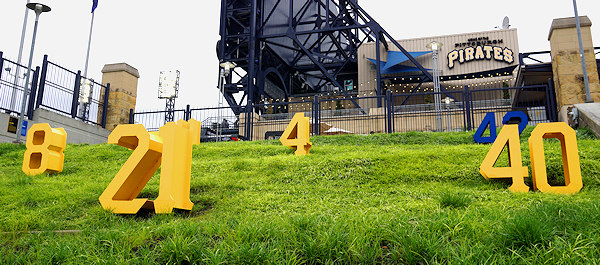
Even more changes were undertaken inside the ballpark.
Smith explains that a security building in centerfield as well as the top three rows of seats on each side of the outfield were removed. “Now you can have fans in this great bar on top of the bullpen. You can watch the game and be in the view at the same time.”
Says Nutting, “Everyone says the best thing about PNC Park is the skyline, and now you can live in it.”
Other additions along the outfield concourse are the pirate-ship-themed play area that Weiland’s son was climbing on, better visibility of the playing field, and a team Hall of Fame (photo below). The latter is next to the Roberto Clemente Gate in centerfield.
“Our goal was to be able to have baseball and the signature aspect of PNC Park (the view) as one experience, not just as a single photo moment,” says Smith
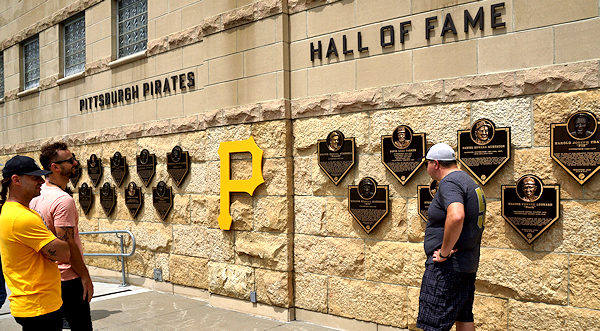
Pirate partners
The Pirates were wise to bring in talented partners to make the fan experience the best it can be. This goes all the way back to the 1990s, when HOK (now called Populous) was asked to design PNC Park.
Firm founders Earl Santee and Joe Spear came to Pittsburgh to meet with officials from the city and Pirates about a possible replacement for the aging cookie-cutter Three Rivers Stadium. Santee recalls the drive from the airport toward downtown. Upon emerging from the Fort Pitt Tunnel, “it just blew me away” as he gazed at the point where the Allegheny and Monongahela Rivers flow together to form the Ohio. And he spotted the site that in 2001 would hold PNC Park.
“We fell in love with Pittsburgh. It allowed us to share a common understanding of what the Pirates desired, to make (the park) authentic for Pittsburgh.”
Food-service vendor Aramark also has a long history with the Pirates, and their concession stands are also “authentic” for the market. “We worked really closely with Aramark to rethink the food and beverage and try to make both the throughput for fans faster and more convenient,” notes Smith. “It’s been a real effort to present food as a contributing factor in how you enjoy the game.”
Food courts were created that veered traffic away from the concourse just behind the seats. Williams notes the goal was to “use new concepts … and technology, and replace a lot of the equipment in order to help with that speed of service and ultimately, the quality of the food offering as well.”
When you want a Ballpark Burgher, you order and pay on a kiosk about 50 feet removed from the stand where you pick up the food. Thus, traffic jams are avoided, even during the games when the team’s phenom pitcher is on the mound.
The Skenes Effect
Patricia Owens of the Oakland section of Pittsburgh works in food services at PNC Park. This seems only natural since her parents first met at a Pirates game.
“I can really tell a difference between last year and this year,” she says. “This year, everyone wants to come to see their favorite pitcher.”
That pitcher is Paul Skenes, last year’s first pick in the MLB draft. His success in the big leagues this season earned him the coveted spot as the National League’s starting pitcher in the All Star Game.
And the Pirates’ fanbase has noticed.
When he made his big-league debut on May 11, the attendance at PNC Park was more than double the average crowd up to that point. In fact, over Skenes’ first eight home starts, attendance averaged 29,858 – 8,109 more than when he wasn’t on the mound.
“Skenes is a global phenomenon,” observes Dan Zangrilli, the team’s pre- and post-game radio host. “Fans can’t get enough of him. We can’t talk about him enough.
“He’s the greatest thing to happen to the franchise in my lifetime.”
It doesn’t hurt that Skenes’ girlfriend, in attendance at most of his starts, is Olivia Dunne – “Livvy” to her 13 million social-media followers. As she sports Pirates attire in her posts, merchandise sales are undoubtedly up.
All of the additional attention on the team, added to the new features of PNC Park, has had a positive impact on the franchise. Through 57 homes dates, attendance in Pittsburgh was up 13.3% over 2023, plus the Bucs had won five more games than at the same time a year before. For a team that hasn’t won a divisional title since 1992, these upticks are welcome indeed.
Considering their last postseason appearance was in 2015, an even more welcome sight would’ve been staying in contention for a National League Wild Card spot through the end of the season. PNC Park, arguably the most appealing venue in the sport, would’ve looked very nice in the playoffs.
Smith credits Pirates ownership with keeping the ballpark fresh. “I want to acknowledge that the leadership of this project came from the top, from Bob Nutting himself.”
Young again
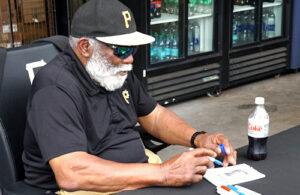 The Pirates’ star catcher from 1967 to 1980 was Manny Sanguillen. During his playing days, he and Johnny Bench were clearly the best catchers in the National League – but the Reds’ slugger consistently garnered more attention than Sanguillen. All these years later, he still bristles when Bench is brought up. “One year, he was batting only .215 and he still got to start the All Star Game instead of me,” he sighs.
The Pirates’ star catcher from 1967 to 1980 was Manny Sanguillen. During his playing days, he and Johnny Bench were clearly the best catchers in the National League – but the Reds’ slugger consistently garnered more attention than Sanguillen. All these years later, he still bristles when Bench is brought up. “One year, he was batting only .215 and he still got to start the All Star Game instead of me,” he sighs.
At the Pirates game on July 24, he was signing autographs next to a concession stand in center field – at the ballpark that opened 21 years after he retired. “I would love to have played here. It’s great. I know I would’ve hit 35 home runs a year here.”
Too bad Manny can’t roll back the years the way the Pirates continually keep America’s best ballpark young.